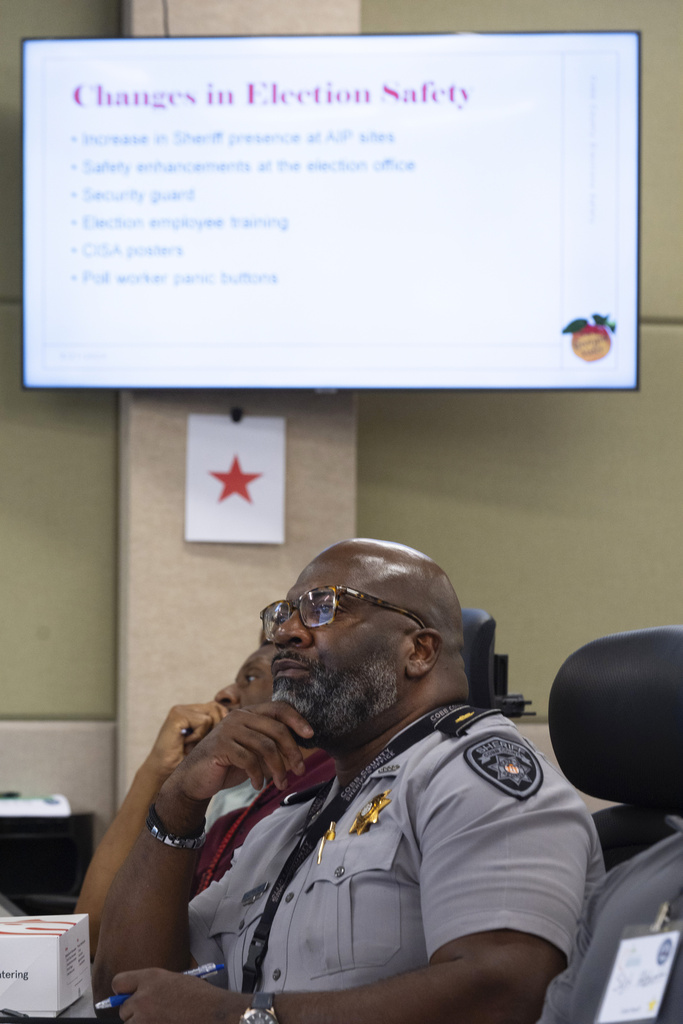The election director in Cobb County, an Atlanta suburb where votes will be fiercely contested in this year’s presidential race, recently organized a five-hour training session. The focus wasn’t solely on the nuts-and-bolts of running this year’s election. Instead, it brought together election staff and law enforcement to strategize on how to keep workers safe and the process of voting and ballot-counting secure.
Having a local sheriff’s deputy at early voting locations and panic buttons that connect poll managers to a local 911 dispatcher are among the added security steps the office is taking this year.
Tate Fall, Cobb County’s election director, said she was motivated to act after hearing one of her poll workers describe being confronted during the state’s presidential primary in March by an agitated voter who the worker noticed was carrying a gun. The situation ended peacefully, but the poll worker was shaken.
“That made it really real for me — that it’s so easy for something to go sideways in life, period, let alone the environment of Georgia and elections,” Fall said. “I just can’t have someone being harmed on my conscience.”
Across the country, local election directors are beefing up their security in advance of Election Day on Nov. 5 to keep their workers and polling places safe while also ensuring that ballots and voting procedures won’t be tampered with. Their concern isn’t just theoretical. Election offices and those who run them have been targets of harassment and even death threats since the 2020 presidential election, primarily by people acting on former President Donald Trump’s lies that the election was stolen from him through widespread fraud or rigged voting machines.
The focus on security comes as threats of political violence have been on the rise. Trump was the target of a potential assassination attempt over the weekend, just nine weeks after another threat on his life. Federal agents last year fatally shot a Trump supporter who threatened to assassinate President Joe Biden, and the husband of former House Speaker Nancy Pelosi was severely injured in a hammer attack by a man promoting right-wing conspiracy theories.
In just the last year, a gun was fired at a window of the Cuyahoga County, Ohio, election office, several election offices in five states were sent letters filled with a white powder that in some cases tested positive for the powerful opioid fentanyl, and bogus 911 calls were made to the homes of top state election officials in Georgia, Maine, Michigan and Missouri in a potentially dangerous situation known as swatting.
“This is one of the things that I have to say is just crazy, outrageous to me — the election threats to workers of both parties and their families, the bullying, the harassment,” Jen Easterly, director of the U.S. Cybersecurity and Infrastructure Agency, said during a recent agency-sponsored online event. “These folks, they are not doing it for pay. They’re not doing it for glory. They’re doing it because they believe it’s the right thing to do to defend our democracy.”
Her agency has completed more than 1,000 voluntary physical security assessments for election offices since the start of 2023. Election officials have been using that help to identify gaps and request money from their local governments to make upgrades.
They also have been aided by a U.S. Election Assistance Commission decision in 2022 that allowed certain federal money to go toward security features such as badge readers, cameras and protective fencing.
California’s Los Angeles County and Durham County, North Carolina, will have new offices with significant security upgrades for this year’s election. They include bulletproof glass, security cameras and doors that open only with badges. Election workers across the country also will have new procedures for handling mail, including kits of Narcan, the nasal spray used for accidental overdoses.
In Durham County, a central feature of the new office will be a mail processing room with a separate exhaust system to contain potentially hazardous substances sent in the mail.
“We have countless reasons why this investment was critical,” said the county’s election director, Derek Bowens, pointing to threats against election officials in Michigan and Arizona and the suspicious letters sent to offices in Oregon, Washington, California and Georgia.
Bowens and others who have worked in elections for years said their jobs have changed significantly. Threats and harassment are one reason why some election officials across the country have been leaving. In some places, election workers are being trained in de-escalation techniques and how to respond to an active shooter.
“Security to this extent wasn’t on the list before. Now it is,” said Cari-Ann Burgess, the chief election official in Washoe County, Nevada. “We have drills that we work through, we have emergency plans that we have prepared. We are a lot more cautious now than we ever have been.”
In Luzerne County, Pennsylvania, about a four-hour drive from where Trump was wounded in an assassination attempt during a campaign rally in July, election officials estimate they now spend about 40% of their time on security and working with local law enforcement and emergency managers on election plans. This involves regular trainings to prepare for anything that might interfere with voting or counting ballots.
“It’s very volatile, and Luzerne County reflects what is going on across the country” said County Manager Romilda Crocamo, who oversees the election office staff. “It seems that people are very emotional, and sometimes that emotion escalates.”
Crocamo is considering purchasing panic buttons for poll managers who will be at some 130 voting locations throughout the county on Election Day. State law in Pennsylvania prohibits law enforcement from being inside polling locations, but Crocamo and her team are speaking with local officials about having emergency responders with their radios at the sites should something happen.
Many local officials said they have increased the law enforcement presence at election offices, including on election night when poll workers are bringing in ballots and other material from voting locations. Added law enforcement also is planned in the weeks after Election Day, during the canvass of the votes and certifying the results.
In Los Angeles, law enforcement canine teams will be helping scan incoming mail ballots for suspicious substances. It’s part of an updated approach that includes a new $29 million election office that consolidates operations that previously had been spread across the county.
Dean Logan, who oversees elections for Los Angeles County, said security remains a top concern. He pointed to social media posts suggesting ways to damage ballot drop boxes and hamper mail voting. He said the letters with white powder were designed to disrupt election operations, and it’s the responsibility of election officials to ensure that doesn’t happen.
The office will have round-the-clock security and additional staffing from the county sheriff’s department for the November election.
“It’s important to me that we can tell voters they don’t have to be worried about the security of their ballots,” he said. “We’ve taken steps to keep them safe.”
Election officials say security is a balancing act, ensuring safety while making sure polling places are welcoming spaces for voters and providing enough access to election offices so the public can trust the process.
In Michigan four years ago, a large crowd of Trump supporters created a tense and chaotic scene when they gathered outside Detroit’s ballot counting operation the day after the election, chanting “Stop the count!” as they banged on the windows and demanded access.
Detroit City Clerk Janice Winfrey said her office is much better prepared this time, with more cameras, armed security and bulletproof glass. Observers will now be checked in and screened by security outside a large room used for counting ballots at the city’s convention center.
“My biggest concern was to protect the staff and the process,” Winfrey said. “And in doing so, our building — it may look the same, but it’s not the same.”
(AP)











